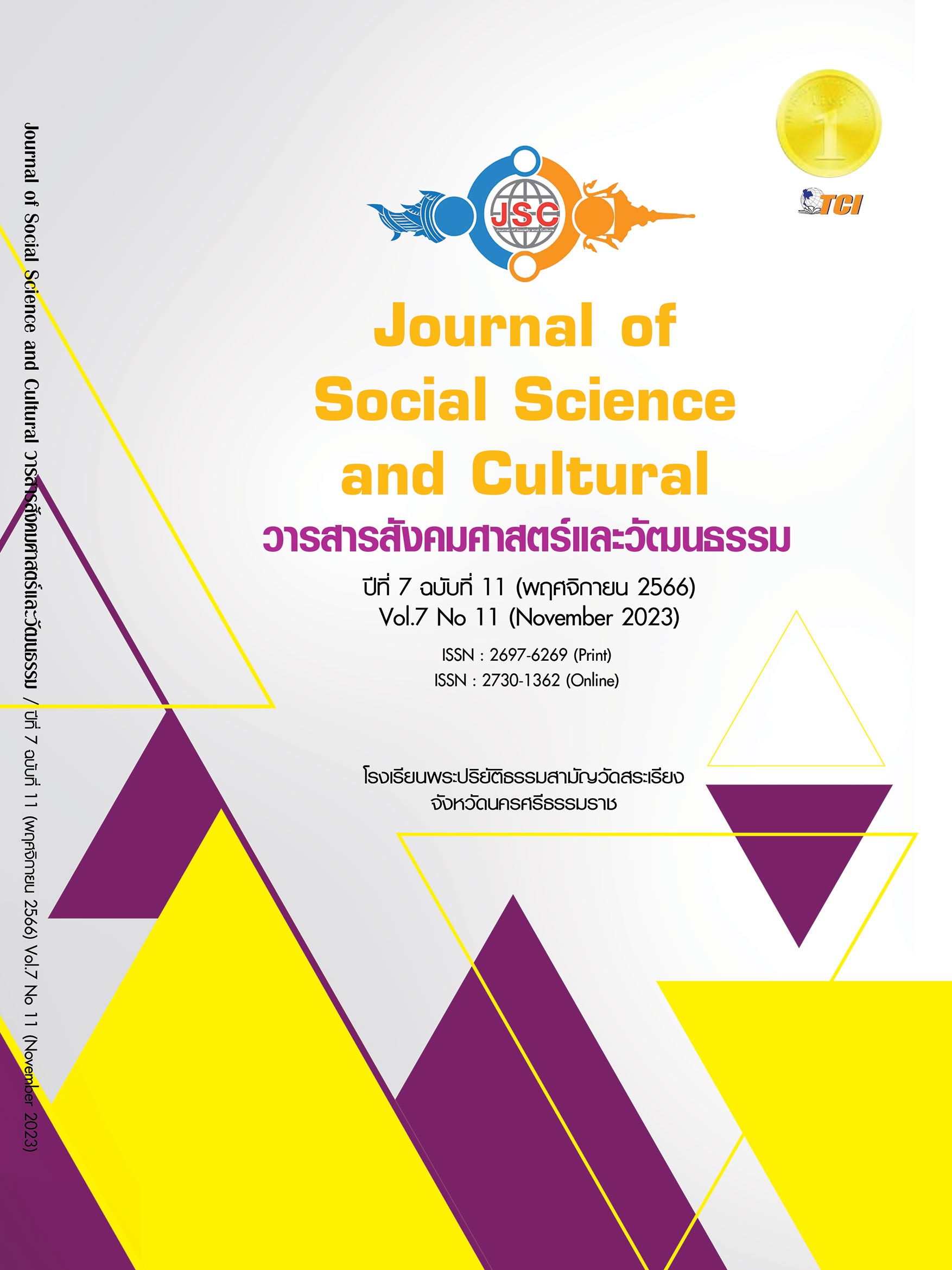DEVELOPING LEARNING MANAGEMENT SKILLS THROUGH ACTIVE LEARNING FOR TEACHERS UNDER THE OFFICE OF THE VOCATIONAL EDUCATION COMMISSION
Main Article Content
Abstract
This article has two main objectives: 1) to develop and evaluate the learning management skills using the active learning approach of teachers under the Office of the Vocational Education Commission; and 2) to examine the satisfaction with the development of learning management skills using the active learning approach of teachers under the Office of the Vocational Education Commission. Through the implementation of the active learning approach into practice for teachers under vocational education in Nong Bua Lamphu Province by purposive sampling). This research is an action research that was conducted in three stages: 1) studying the teaching and learning using the active learning approach; 2) implementing the active learning teaching and learning approach; and 3) studying the satisfaction with the development of teaching and learning skills using the active learning approach with learning objectives in three dimensions: knowledge, skills, and teacher characteristics. The research found that the researchers have developed types of activities based on the characteristics of learning and teaching together with examples of the active learning method, which teachers designed the learning and teaching process through types of activities emphasizing student participation, interaction and having an appropriate environment for learners. These activities consist of seven components, including balance activity, Power of Team activity, plasticine activity, circle activity, discussion and exchange activity, Ping-wap Question activity, and Hold-my-hand activity. The evaluation results based on the learning objectives in all three aspects have met the criteria, with a minimum of 70% and reaching a maximum of 87.6% in terms of teacher characteristics. Satisfaction with the learning objectives in all three aspects is rated as very satisfied. The highest level of satisfaction is found in the learning objectives related to teacher characteristics.
Article Details
References
ครูอาชีพดอทคอม. (2565). ทำความรู้จักกับกรวยประสบการณ์ Cone of Experience เพื่อปรับการสอนให้เป็น Active Learning! เรียกใช้เมื่อ 17 พฤศจิกายน 2566 จาก https://www.kruachieve.com
ทรงนคร การนา. (2562). การพัฒนาหลักสูตรฝึกอบรมสมรรถนะอาจารย์ใหม่ด้านการออกแบบแผนบทเรียนรูปแบบ MIAP เพื่อจัดการเรียนการสอนแบบ ACTIVE LEARNING. วารสารครุศาสตร์อุตสาหกรรม, 18(3), 80-90.
ธีรังกูร วรบำรุงกุล และคณะ. (2563). กิจกรรมสนับสนุนรูปแบบการเรียนรู้เพื่อพัฒนาทักษะของผู้เรียนในศตวรรษที่ 21 ด้านทักษะการเรียนรู้และนวัตกรรม ของโรงเรียนในภาคตะวันออก. วารสารมหาจุฬานาครทรรศน์, 7(9), 283-300.
นวพร ชลารักษ์. (2558). บทบาทของครูกับการเรียนการสอนในศตวรรษที่ 21. วารสารวิชาการมหาวิทยาลัยฟาร์อีสเทอร์น, 9(1), 64-71.
บุหงา วชิระศักดิ์มงคล. (2555). พลวัตกลุ่ม: พื้นฐานการทำงานร่วมกัน. วารสารราชพฤกษ์, 10(2), 6-17.
พีรภรณ์ บุญสมพร. (2564). การพัฒนารูปแบบการจัดการเรียนรู้ตามแนวคิด Active Learning เพื่อพัฒนาทักษะการอ่านและการเขียนภาษาไทย โดยใช้นิทานพื้นบ้านปักษ์ใต้บ้านเรา สำหรับนักเรียนชั้นประถมศึกษาปีที่ 3. วารสารมหาวิทยาลัยมหามกุฎราชวิทยาลัย, 10(2), 1-11.
รุจโรจน์ แก้วอุไร. (2543). การพัฒนาระบบการเรียนการสอนผ่านเครือข่ายใยแมงมุม. ใน ดุษฎีนิพนธ์การศึกษาดุษฎีบัณฑิต สาขาวิชาเทคโนโลยีทางการศึกษา. มหาวิทยาลัยศรีนครินทรวิโรฒ.
วาสนา บุญมาก. (2562). การพัฒนารูปแบบการนิเทศแบบบูรณาการเพื่อส่งเสริมสมรรถนะการจัดการเรียนรู้เชิงรุกของครู ระดับการศึกษาขั้นพื้นฐาน. ใน วิทยานิพนธ์การศึกษาดุษฎีบัณฑิต สาขาหลักสูตรและการสอน. มหาวิทยาลัยนเรศวร.
วีระยุทธ์ ชาตะกาญจน์. (2558). การวิจัยเชิงปฏิบัติการ Action Research. วารสารราชภัฏสุราษฎร์ธานี, 2(1), 29-49.
ศูนย์นวัตกรรมการเรียนรู้ จุฬาลงกรณ์มหาวิทยาลัย. (2562). Active Learning. เรียกใช้เมื่อ 19 ตุลาคม 2566 จาก https://lic.chula.ac.th/images/Active%20Learning/Active%20Learning_01.pdf
สำนักงานเลขานุการของคณะกรรมการยุทธศาสตร์ชาติ สำนักงานคณะกรรมการการพัฒนาเศรษฐกิจและสังคมแห่งชาติ. (2561). ยุทธศาสตร์ชาติ พ.ศ. 2561 - 2580 (ฉบับย่อ). เรียกใช้เมื่อ 19 ตุลาคม 2566 จาก https://www.nesdc.go.th/download/document/SAC/NS_SumPlanOct2018.pdf
สำนักงานคณะกรรมการการอาชีวศึกษา. (2566). นโยบายการพัฒนาอาชีวศึกษา ของสำนักงานคณะกรรมการการอาชีวศึกษา ประจำปีงบประมาณ พ.ศ. 2567 ภายใต้นโยบายการศึกษาของกระทรวงศึกษาธอการ โดยรัฐมนตรีวาการกระทรวงศึกษาธิการ (พลตำรวจเอก เพิ่มพน ชิดชอบ). เรียกใช้เมื่อ 17 พฤศจิกายน 2566 จาก https://www.vec.go.th/Portals/0/%202567.pdf
สำนักงานรับรองมาตรฐานและประเมินคุณภาพการศึกษา (องค์การมหาชน). (2565). รายงานการประกันคุณภาพภายนอก: ผลกาตรวจเยี่ยมภายใต้สถานการณ์ COVID-19 (การตรวจเยี่ยมผ่านระบบวิธีการทางอิเล็กทรอนิกส์) โรงเรียนตะคร้อพิทยา. กรุงเทพมหานคร: สำนักงานรับรองมาตรฐานและประเมินคุณภาพการศึกษา (องค์การมหาชน).
สำลี รักสุทธิ. (2546). คู่มือการเขียนแผนการจัดการเรียนรู้ตามเกณฑ์ใหม่ของ กค. กรุงเทพมหานคร: พัฒนาศึกษา.
สุจิตรา ตรีรัตนนุกูล และคณะ. (2562). การพัฒนากิจกรรมการเรียนรู้เชิงประสบการณ์สำหรับส่งเสริมกรอบความคิดด้านเชาวน์ปัญญาของนักศึกษาระดับอาชีวศึกษา. วารสารบัณฑิตศึกษา มหาวิทยาลัยราชภัฏสวนสุนันทา, 12(1), 101-115.
หทัยชนก พรรคเจริญ. (2555). เทคนิคการเลือกตัวอย่าง. เรียกใช้เมื่อ 17 พฤศจิกายน 2566 จาก https://service.nso.go.th/nso/nsopublish/Toneminute/files/55/0203-5.pdf
Bonwell, C. C. & Eison, J. A. (1991). Active Learning: Creation Excitement in the Classroom. ERIC Clearinghouse on Higher Education: Washington: George Washington University.
Kemmis, S & McTaggart, R. (1988). The Action Research Planer (3rd ed.). Victoria: Deakin University.
Meyers, C. & Jones, T. B. (1993). Promoting active learning: Strategies for the college classroom. San Francisco: Jossey-Bass.
Partnership for 21st century skills. (2009). Framework for 21st Century Learning. Retrieved October 19 , 2023, from www.21st centuryskill.org/p21.org/our-work/p21-framework


